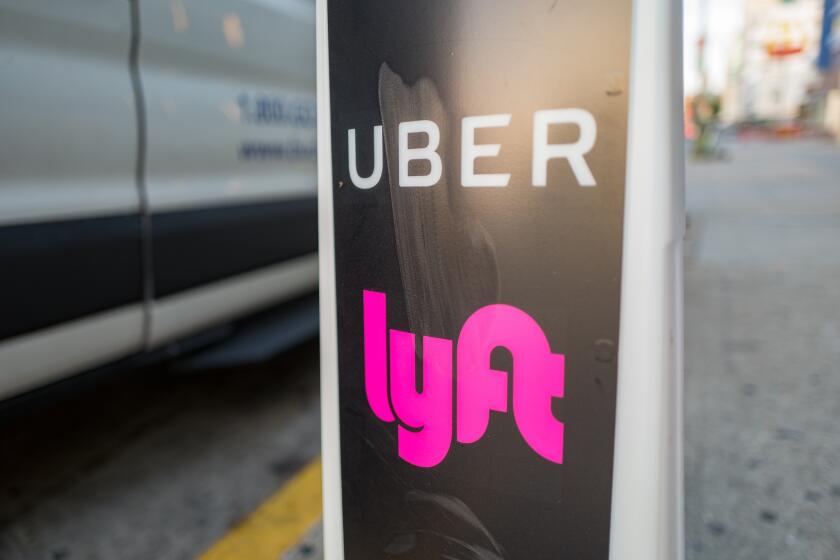Corporate Absence Leaves San Diego as a Branch-Office City : Status Affects Community Ability to Raise Money to Benefit Civic and Social Causes
- Share via
It was quite a shocker for Lindsey Nelson, the new director of the St. Louis Repertory Theater. When he took the job four years ago, he opened the financial books and discovered that the troupe had a $100,000 deficit.
Hardly an auspicious beginning. With a lump in his throat, Nelson walked into his first board meeting a few days later and broke the bad news to the theater’s directors, who included top executives from some of the region’s largest firms.
“He said that, around the board table, they raised the ($100,000) right then,” said Bill Nelson, Lindsey’s father and immediate past chairman of the Greater San Diego Chamber of Commerce. “You have companies in St. Louis--Seven-Up Bottling, Brown Shoe and Anheuser Busch--that do it.
“That would not have happened in San Diego,” said Nelson, referring to the ease with which the St. Louis companies erased the debt around the table.
Few Corporate Headquarters
The reason that would not have happened in San Diego, Nelson and other leaders believe, is obvious: There are few large corporate headquarters and high-ranking business executives in America’s seventh-largest city.
San Diego County is home for only two of Fortune Magazine’s 500 largest, publicly owned industrial corporations--Rohr Industries of Chula Vista and Fisher Scientific of La Jolla. Of the region’s 64,000 firms, 95% employ 50 people or fewer.
The absence of large corporations is the main reason civic boosters are reacting so strongly to the news that Rosemead-based Southern California Edison plans to acquire San Diego Gas & Electric Co. SDG&E; would not be the first headquarters to go: Wickes Corp., the Signal Cos., and Pacific Southwest Airlines are major companies that have disappeared from the landscape over the last several years through mergers or bankruptcy.
Scramble for Money
Whether SDG&E; is taken over or not, San Diego is a branch-office town, say local business leaders, sociological experts and fund-raisers. And they say the consequences are plain:
Symphony and art museum development officers are forced to scramble harder for money than their counterparts in cities where Fortune 500 companies are based. Special programs--such as the San Diego Compact, a coalition of business and labor leaders formed to help curb the high school dropout rate--take longer to coalesce than in other communities. Important public works projects, such as finding a spot for a new international airport, are allowed to drift.
San Diego businesses lag far behind their counterparts in supporting the wide range of social causes embraced by the United Way, statistics show. San Diego firms ranked 54th out of 57 in terms of how much they gave per employee to the United Way campaign last year. Other cities where the business community did better included Birmingham, Ala.; Chattanooga, Tenn.; Akron, Ohio; Grand Rapids, Mich.; Kansas City, Mo.; Memphis; Toledo, Ohio; Flint, Mich.; Richmond, Va., and Fort Worth, Tex.
Lee Grissom, president of the Greater San Diego Chamber of Commerce, said the exodus of major companies represents a “slow hemorrhaging of business leadership and corporate leadership that has been going on for a long time.”
Grissom was so exasperated by the prospect of SDG&E;’s departure that he sarcastically proposed earlier this year changing the name of the area to “Branch Diego.”
“As a San Diegan, the one thing that I’m most concerned about is something urban sociologists call ‘anomie.’ It means a kind of rootlessness, a lack of identity . . . . We are--in a business sense, a community sense--becoming almost an anonymous community,” said Grissom.
Just Passing Through
UC Santa Barbara sociologist Roger Friedland said executives in a branch-office town see themselves as just passing through because their careers are geared toward obtaining a nameplate and a desk at the company headquarters.
“What does that mean to an executive who is located in a branch plant in San Diego?” Friedland said. “It means that he is waiting . . . and hoping that if he does a great job, he’s going to get promoted to the head office in Chicago, Los Angeles or whatever.
“You don’t think you’re going to be there forever,” Friedland said, “so you don’t invest as much in building a life in San Diego.”
Former San Diego City Councilman Mac Strobl says: “I call it the ‘Have Briefcase, Will Travel’ mentality.”
Of course, having a cadre of Fortune 500 and other large companies based in a city does have its disadvantages, say Friedland and other experts. The firms can have a paternalistic influence on state and local politics, sometimes bending the public will to serve their corporate purposes, they say.
On the Plus Side
Yet there are some distinct advantages to having large corporate headquarters in town, say sociologists and business leaders. Home offices create extra jobs; attorneys, bankers, small businessmen, advertising agencies and management consultants open offices to service the mammoth corporations.
In addition, a city’s statewide and national prestige increases. The major corporations send out their CEOs, senior vice presidents, lobbyists and employees to befriend politicians, make campaign contributions and influence legislation. In return, legislators are quicker to respond when the corporation’s hometown city needs a public works project or more government aid, they say.
Meanwhile, top corporate executives will become directly involved in the local causes and projects of their headquarters city. Long-term involvement is often encouraged down the chain of command because executives believe their hometown is a reflection on the company, said Hayden Smith, council for Aid to Education.
“The welfare of the city becomes a matter of corporate interests,” said Smith. “After all, they (companies) want to attract good people to work. Good people look at the community in which they live, and that’s one of the attractions of the company. Every company worth its salt is worried about that.”
Michael Useem, a Boston University sociologist, said that, on average, a CEO and his senior vice presidents will dedicate about five hours a week to serve on three to five boards of nonprofit organizations in their hometown.
“When the chief executive is serving on a hospital board and it has a $100-million campaign, he can go back to his company and say, ‘Let’s get this going. We’ll give $50,000 to $100,000 to initiate the effort,’ ” Useem said.
Statistics compiled by the Conference Board, a New York-based group that studies corporate giving, showed that companies concentrate 26% of their donations on hometown causes, while parceling out 37% among remaining branch offices and plants. The other37% goes to national causes.
Hometown Affairs
In addition, corporate officers are often active in their hometown affairs. In Dallas, for example, former Mayor Bob Thornton Sr. called business leaders together in 1936 to form what he called the “Yes” club.
“That means when I ask you for money or I ask you to do something, you say ‘Yes,’ ” he told the group, which went to work immediately on a successful effort to lure the state’s Centennial celebration to Dallas.
Since then, the group--called the Dallas Citizens Council--has been a powerful behind-the-scenes force in the Texas city. Composed of chief executive officers of Dallas’ 250 biggest firms, the council has indirectly “controlled the agenda” by working on such civic problems as mass transit and raising money for civic treasures, like the new symphony hall, said Jan LeCroy, the council’s president.
Corporate Clout
While San Diego has a larger population than Dallas, it is far behind the Texas city in terms of corporate clout, according to the 1988 Fortune 500 list of the largest industrial companies in America.
Dallas is home for 12 companies on the list. San Diego has two.
That is not to say San Diego is devoid of corporate headquarters. Smaller publicly held companies with headquarters here include Cubic Corp., Intermark, Aerojet General, the Price Company, WD-40 and the Triton Group. Privately held companies include the Copley Press, General Atomics, SAIC Corp. and Big Bear Markets.
Great American First Savings Bank and Home Federal Savings & Loan rank in the top 10 savings and loans in the country.
But many of the corporate heavyweights have closed up headquarters because of mergers or bankruptcy. Gone is Pacific Southwest Airlines, which merged with USAir. The Signal Cos., a transplant from Los Angeles, dissolved when it split into two Fortune 500 companies--Fisher, in La Jolla, and the Henley Group, in New Hampshire. Wickes Cos. located in San Diego from Michigan before it went belly-up.
The largest and most successful biotechnology firm in San Diego was Hybritech, which now is a subsidiary of Eli Lilly Co., based in Indianapolis.
Now, SDG&E; may be on its way out, and with it a donations budget that will reach $1.3 million in 1989. Southern California Edison has promised to slightly increase or keep the budget steady during the next five years, said Dick Manning, SDG&E;’s vice president of public relations.
The loss of SDG&E; could be a psychological blow, say community leaders. San Diego would become the largest city in the country without its own utility, according to the Economic Development Corp.
The exodus leaves a San Diego economy dominated by branch offices, small companies and start-up biomedical and electronics firms. Of the region’s 64,000 businesses, 95% of them employ fewer than 50 persons, according to “Future Scan,” a United Way study of demographic trends into the 1990s. The county’s largest private sector employer, General Dynamics, answers to a headquarters office in St. Louis.
Yearning Not ‘Realistic’
Yearning to be a headquarters town may not be “realistic” for San Diego, said Gerald Trimble, former head administrator of Centre City Development Corp.
“Maybe there’s a downside, but from the people’s standpoint, it may not be a negative thing at all,” said Trimble, now head of the University of Southern California Real Estate Development Corp. in Los Angeles. “You don’t have these major corporations influencing decisions.”
Richard A. Cramer, CEO for Fisher Scientific, said he’s not concerned about the lack of corporate home offices.
“We just may have to face the fact that for the next decade, we won’t have a lot of corporate headquarters,” he said. “But I’m saying it’s not a fundamentally negative thing.
“If I had to trade off five new biotech companies, all of which are growing and are creating new jobs . . . I’d rather have those five than one corporate name that hires 15 people.”
Nelson, who stepped down as chamber chairman on Thursday, said the current business environment of branch offices and small firms is ripe for a large corporation to move in and immediately assume a position of corporate leadership.
“We had an era in San Diego where things were done by a small number of people, like (financier) C. Arnolt Smith and (publisher) Jim Copley,” Nelson said. “They would pick up the phone and call, and City Hall would jump to. . . .
“Right now, we have a wide-open social access in the corporate level. If you have energy and talent, you’re going to be accepted. You don’t have to work with one of the silk-stocking banks or manufacturing firms or the oldest manufacturing firm in town.”
Getting Involved
Such was the case with Signal Cos., which moved its headquarters from Los Angeles to San Diego in 1980. Under the leadership of Forrest N. Shumway, Signal’s 63 executives fanned out through the community and took positions on a wide range of boards, including the USO, the museums, the symphony and the opera.
In 1985, Signal also contributed $1.3 million to local causes, according to statistics compiled by the San Diego Community Foundation.
Shumway said San Diego, although large in population, is still a “small, close-knit” corporate community.
“Down here, with 10 phone calls, you can talk to all of the major corporations,” Shumway said. “In L.A., it would take you two weeks.”
When Signal’s headquarters left town in 1987, leaving behind successor companies Fisher Scientific and the Henley Group, some of its executives retired but continued their civic involvement, said a Fisher spokesman.
And both successor companies come close to the $1.3 million in contributions made by Signal just two years ago. Fisher donates “in the six figures” and the Henley spent $650,000 last year on local organizations, company spokesmen said.
The absence of major corporate headquarters means that cultural fund-raisers have a tougher task, said Wed Brustad, executive director of the San Diego Symphony.
“It means a lot because decisions are made in other cities for operations here. So you don’t have an empathy for the local community that would exist if their headquarters were here. It’s a real problem,” he said.
Smaller Gifts
The size of gifts given through branch offices tend to be smaller, he said. For instance, corporate sponsors Home Federal and Great American have given the symphony gifts in the “six figures,” but then the pack falls off significantly to $25,000, $10,000 and $5,000 gifts, said Brustad.
“When the size of gifts goes down, you have to spend so much time and effort getting more gifts, and that costs money administratively,” he said.
The same is true for the United Way campaign, in which San Diego corporations have an abysmal record for donations per employee. A 1987 United Way survey of corporate giving showed that Hartford was first, with $17.94 donated per employee.
Near the bottom of the list--54th out of 57--was San Diego, with an average of $4.17 per employee. San Diego corporations were outperformed by those in Minneapolis ($15.80), Cincinnati ($12.80), Toledo ($11.21), Dallas ($9.54), Kansas City ($6.97), Detroit ($6.71), Baltimore ($5.99) and Denver ($5.58).
The branch office syndrome shows itself in other ways, too.
Jeanne Jehl, an administrator for the San Diego schools, said that plans for the San Diego Compact--a business and labor alliance aimed at cutting the drop-out rate--were stalled for more than a year after its biggest advocate, John Hanson from Solar Turbines, was transferred to the home office.
“The person who said ‘This is important and here’s the commitment from my company’ was gone,” said Jehl. “We had almost a year without someone willing to chair the compact.”
San Diego also suffers politically from the lack of corporate heavyweights, said Strobl, president of the TCS Government Consulting firm.
“I think most people would agree that in the classic sense, there is a power vacuum in San Diego today,” said Strobl. “If you would go back 15, 20 years, you would have found those kind of corporate executives contributing and participating in the major decisions that confront the community.
“A lot of those businesses that are part of that group are gone, absorbed,” he said. “Some of the executives have made their contribution and are looking toward others to fill that need and I’m not sure there are that many others that can step in.”
Louis Wolfsheimer, land-use attorney and Port District commissioner, said, “If the mayor wanted to put a rush committee together to save this or save that, who the hell can she go to? The leading citizens of the town? How many times can you go to Kim Fletcher (chairman of Home Federal), Gordon Luce (chairman of Great American) and Malin Burnham (chairman of First National Bank)? They’re the same three guys you think of all the time.”
Luce agrees. “We need others to build the community, to help the civic, cultural, health and philanthropic organizations,” he said. “Many of the branch officers of major corporations are active in the community . . . but the more we have of corporate headquarters, the better.”
Grissom said the chamber has heard the cry for help, and this year launched a program called “Discover San Diego,” a series of workshops aimed at immersing branch managers and their wives in community involvement. The program is a series of workshops to teach executives about San Diego’s history and civic leaders and acquaint them with how they can become involved, said Grissom.
The La Jolla Museum of Contemporary Art has also begun a campaign, in part funded by the California Arts Council, to increase its business support, which supplies just $75,000 of its $2.17 million budget.
“We are hampered by that branch-office town concept,” said Anne Farrell, the museum’s development director.
Biding Time
Yet the only thing San Diego may be able to do is wait for some of its new companies to grow and assume the mantle of corporate leadership.
Nelson said his hopes are riding on the burgeoning biotech and electronics industry, but he added it will take at least 15 years before those firms become stable enough to take their eyes off the bottom line. Currently, their executives are much too busy trying to survive technological change to get involved in civic endeavors, he said.
Richard H. Davis, former head of the Economic Development Corp., said it may take even longer.
“People who expect us, because we’re the seventh-largest city, to have the seventh-largest cultural or corporate base, are somewhere between 30 and 100 years ahead of their time,” he said.
WHERE TOP COMPANIES ARE BASED
The nation’s top 20 cities, listed by population, and the number of Fortune 500 companies with headquarters in each.
CITY FORTUNE 500 FIRMS New York 50 Los Angeles 11 Chicago 26 Houston 12 Philadelphia 6 Detroit 7 San Diego 2 Dallas 12 Phoenix 1 San Antonio 2 Honolulu 1 Baltimore 1 San Francisco 5 Indianapolis 1 San Jose, Calif. 0 Memphis, Tenn. 1 Washington, D.C. 2 Milwaukee, Wis. 4 Jacksonville, Fla. 1 Boston 2
Source: Fortune Magazine
CORPORATE GIVING
San Diego ranks 54th out of 57 cities in terms of how much its corporations gave per employee to the 1987 United Way campaign. Following is a list of selected cities from that ranking.
CITY CORPORATE GIVING/ PERSON EMPLOYED Hartford, Conn. $17.94 Minneapolis $15.80 Cleveland $14.62 Philadelphia $13.37 Cincinnati $12.80 St. Louis $11.69 Toledo, Ohio $11.21 Pittsburgh $11.03 Seattle $10.98 Chattanooga, Tenn. $10.77 Houston $9.92 Omaha, Neb. $9.91 Boston $9.74 Dallas $9.54 Los Angeles $9.00 Indianapolis $8.91 Chicago $8.65 Atlanta $8.15 Richmond, Va. $8.05 Portland, Ore. $7.74 Grand Rapids, Mich. $7.61 Kansas City, Mo. $6.97 New York $6.95 Fort Worth $6.91 Detroit $6.71 Baltimore $5.99 New Orleans $5.98 Washington $5.96 Denver $5.58 Flint, Mich. $5.23 Phoenix $4.89 San Diego $4.17 Sacramento $2.41 Long Island, N.Y. $1.80
Source: United Way
More to Read
Inside the business of entertainment
The Wide Shot brings you news, analysis and insights on everything from streaming wars to production — and what it all means for the future.
You may occasionally receive promotional content from the Los Angeles Times.










